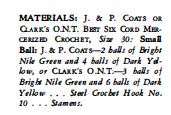Yarn substitution can be a tricky process. If you are lucky, you will not find yourself substituting yarn for a project that calls out discontinued yarn. The more time passes, the higher the likelihood of this being the case. Fashions change, as well as resources, so what may have been considered a common yarn 20, 30, or even 80 years ago may not be as common now. It may be so uncommon that serious research is involved just to find out what it really is. (More on Victorian knitting later!)
The Daffodil Doilie project I have been crocheting calls for discontinued yarn. Specifically, either J. & P. Coats or Clark's O.N.T. Best Six Cord Mercerized Crochet, Size 30.
I consider myself fortunate that these brands at least ring a bell. J. & P. Coats and Clark's is now more commonly known under the name Coat's and Clark's. According to their website (which has a fairly entertaining timeline about their history, if thread history interests you) O.N.T ("Our New Thread") is a special six cord, soft finished thread for sewing machines first marketed in 1860.
Now, I don't know about you, but I'm fairly certain this pattern from 1949 is not asking me to crochet this doilie out of sewing machine thread. I gather that O.N.T. has become a trademark, having made a big splash back in Victorian times. A straight Google of O.N.T. Best Six Cord Mercerized Crochet, Size 30 gets me more in the realm of what is typically thought of when we say "crochet thread" - that is, this discontinued thread. 1949 really wasn't very long ago, and if I was die-hard about it, I could probably set up an alert on eBay to purchase the exact thread this pattern calls for in vintage yarn.
I opted for something manufactured within the past decade instead, and for several reasons. I didn't really want to wait to find the thread and wait for it to be shipped. Who knows when it would turn up? Waiting during shipping is hard enough. But impatience aside, I've learned the hard way that cotton just doesn't hold up as well over the years as wool or other fibers. I've had many a strand of vintage embroidery or crocheting thread disintegrate on me as I worked it, but have never had it happen with wool.
There are several big players in the modern market of crochet thread. Aunt Lydia by Red Heart (which is owned by Coat's and Clark's) and DMC come foremost to mind. However, in size 30 both brands come in a limited range of colors. (Think "50 Shades of White.") In the end, I went to a brand I'd never heard of, Omega Hilo Crochet in Pistachio and Bright Yellow. I still don't know much about them, but I do know something essential: they have Size 30 crochet thread in OVER 60 COLORS. And it's accessible. (More on my heart wrenching quest to get Brown Sheep Nature Spun Fingering balls in specific colors later.)





